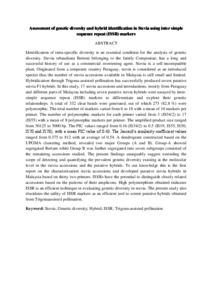Citation
Othman, Halimaton Saadiah and Zainuddin, Zarina and Osman, Mohamad
(2016)
Assessment of genetic diversity and hybrid identification in Stevia using inter simple sequence repeat (ISSR) markers.
Transactions of Persatuan Genetik Malaysia (3).
pp. 157-162.
Abstract
Identification of intra-specific diversity is an essential condition for the analysis of genetic diversity. Stevia rebaudiana Bertoni belonging to the family Compositae, has a long and successful history of use as a commercial sweetening agent. Stevia is a self-incompatible plant. Originated from a temperate country Paraguay, stevia is considered as an introduced species thus the number of stevia accessions available in Malaysia is still small and limited. Hybridization through Trigona-assisted pollination has successfully produced seven putative stevia F1 hybrids. In this study, 17 stevia accessions and introductions, mostly from Paraguay and different parts of Malaysia including seven putative stevia hybrids were assayed by inter-simple sequence repeat (ISSR) markers to differentiate and explore their genetic relationships. A total of 332 clear bands were generated, out of which 275 (82.8 %) were polymorphic. The total number of markers varied from 6 to 18 with a mean of 10 markers per primer. The number of polymorphic markers for each primer varied from 3 (IS34/2) to 17 (IS55) with a mean of 8 polymorphic markers per primer. The amplified product size ranged from 50125 to 5000 bp. The PIC values ranged from 0.16 (IS34/2) to 0.5 (IS19, IS55, IS50, IS70 and IS78), with a mean PIC value of 0.43. The Jaccard‘s similarity coefficient values ranged from 0.375 to 812 with an average of 0.54. A dendrogram constructed based on the UPGMA clustering method, revealed two major Groups (A and B). Group-A showed segregated Bertam while Group B was further segregated into seven subgroups consisted of the remaining accessions studied. The present findings unarguably suggest extending the scope of detecting and quantifying the prevalent genetic diversity existing at the molecular level in the stevia accessions and the putative hybrids. To our knowledge this is the first report on the characterization stevia accessions and developed putative stevia hybrids in Malaysia based on thirty two primers. ISSRs have the potential to distinguish closely related accessions based on the patterns of their amplicons. High polymorphism obtained indicates ISSR is an efficient technique or evaluating genetic diversity in stevia. The present study also elucidates the utility of ISSR markers as an efficient tool to screen putative hybrids obtained from Trigonaassisted pollination.
Download File
![[img]](http://psasir.upm.edu.my/46530/1.hassmallThumbnailVersion/Assessment%20of%20genetic%20diversity%20and%20hybrid%20identification%20in%20Stevia%20using%20inter%20simple%20sequence%20repeat%20%28ISSR%29%20markers.pdf)  Preview |
|
Text
Assessment of genetic diversity and hybrid identification in Stevia using inter simple sequence repeat (ISSR) markers.pdf
Download (154kB)
| Preview
|
|
Additional Metadata
Actions (login required)
 |
View Item |

